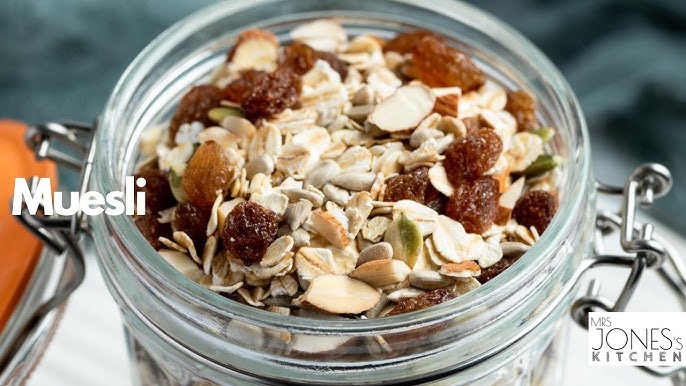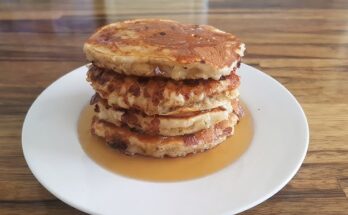Muesli Recipe: Muesli is a wholesome and hearty breakfast dish that combines a mix of rolled oats, dried fruits, nuts, seeds, and sometimes fresh fruit. Originally invented by Swiss physician Maximilian Bircher-Brenner in the early 1900s, muesli was designed to be a healthy, energy-boosting meal for patients. Unlike granola, muesli is typically raw and not baked, meaning it retains more of its natural nutrients. It’s incredibly versatile and can be eaten with milk, yogurt, or even fruit juice, offering endless possibilities for every palate.
Why Muesli is a Healthy Choice?
If you’re looking for a breakfast that’s packed with nutrients, muesli is your best friend. It’s high in fiber, which helps digestion, and loaded with essential vitamins and minerals from the nuts and dried fruits. The oats provide slow-releasing energy to keep you fueled all morning. Plus, making your own muesli means you can control the sugar content, unlike many store-bought versions that sneak in lots of hidden sugars.
Ingredients Needed for Homemade Muesli
Core Ingredients
To whip up a batch of classic homemade muesli, you’ll need:
- Rolled oats – the star of the show.
- Nuts – like almonds, walnuts, or hazelnuts for crunch and protein.
- Seeds – chia, sunflower, or pumpkin seeds for added nutrition.
- Dried fruits – raisins, cranberries, apricots, or dates for sweetness.
These basics form the foundation of any great muesli recipe.
Optional Add-ins
Feel free to get creative! Some other delicious add-ins include:
- Shredded coconut for a tropical twist.
- Spices like cinnamon or nutmeg to enhance the flavor.
- Puffed rice for a light, airy texture.
- Dark chocolate chips (sparingly!) for an indulgent treat.
Homemade muesli is a playground for your imagination.
Step-by-Step Guide to Making Muesli
Step 1: Gathering Your Ingredients
Start by laying out all your chosen ingredients. Having everything ready will make the process smooth and efficient. Measure out your oats first—they will make up about 60-70% of the mixture.
Step 2: Mixing the Base
In a large mixing bowl, combine your oats, nuts, and seeds. Stir them gently to distribute everything evenly. This base should be well mixed because it sets the tone for every bite you’ll enjoy later.
Step 3: Adding the Extras
Now, toss in your dried fruits and any optional add-ins like coconut or spices. If you’re adding chocolate chips, make sure your mixture is cool and dry so the chocolate doesn’t melt and clump.
Step 4: Storing Your Muesli Properly
Transfer your muesli into an airtight container. Store it in a cool, dry place, and it should stay fresh for up to a month. If you live in a humid area, consider keeping it in the fridge to maintain freshness.
Tips to Customize Your Muesli
Flavor Variations
You can tailor your muesli to suit any taste preference. Love tropical flavors? Add dried pineapple and coconut flakes. Craving a dessert vibe? Mix in cocoa powder and dark chocolate chunks. Experiment with seasonal fruits and spices like pumpkin spice in autumn for a cozy twist.
Texture Preferences
If you like a crunchier texture, consider lightly toasting the oats and nuts in the oven before mixing. Prefer something softer? Soak your muesli overnight in milk or yogurt for a creamy, porridge-like experience.
How to Serve Muesli
Traditional Serving Style
The classic way to enjoy muesli is simple: pour it into a bowl and add cold milk or your favorite plant-based milk. Let it sit for a few minutes to soften slightly, and enjoy!
Creative Serving Ideas
- Overnight oats style: Mix with yogurt and leave it overnight.
- Smoothie topper: Sprinkle on your morning smoothie for a crunchy boost.
- Muesli parfait: Layer with yogurt and fresh fruits for a stunning breakfast jar.
Nutritional Benefits of Muesli
Homemade muesli is a nutritional powerhouse. It’s packed with fiber, essential fatty acids, vitamins, minerals, and plant-based protein. Regularly eating muesli can help lower cholesterol levels, maintain healthy digestion, and provide a steady stream of energy throughout the day. Plus, with no added sugars or preservatives, it’s a much healthier choice compared to many processed breakfast cereals.
FAQs about Muesli Recipe
Is muesli healthier than granola?
Yes! Muesli is generally healthier than granola because it is typically raw and has no added oils or sweeteners. Granola is often baked with honey or sugar, making it higher in calories and fats compared to the natural simplicity of muesli.
Can I eat muesli every day?
Absolutely. Muesli is packed with fiber, vitamins, and minerals that support a healthy digestive system and overall well-being. Just be mindful of portion sizes and toppings to avoid excess calories.
What can I add to my muesli for extra flavor?
You can customize your muesli with a variety of delicious additions like fresh fruits (bananas, berries, apples), nuts (almonds, walnuts), seeds (chia, flaxseeds), and even a dollop of Greek yogurt or a splash of almond milk.
Do I need to soak muesli before eating?
While you can enjoy muesli dry like cereal, soaking it in milk, yogurt, or juice overnight (a.k.a. overnight oats style) softens the grains and enhances the flavor, making it easier to digest.
Is homemade muesli better than store-bought?
Definitely! Homemade muesli allows you to control the ingredients — no added sugars, preservatives, or unwanted additives. Plus, you can tailor it exactly to your taste preferences.
Conclusion
Making your own muesli is incredibly easy, cost-effective, and rewarding. You get full control over what goes into your bowl, ensuring every bite is packed with flavors and nutrients you love. Whether you prefer it crunchy or soft, simple or loaded with extras, muesli is the perfect breakfast to keep you energized and satisfied. Give it a try—you’ll never go back to store-bought again!



